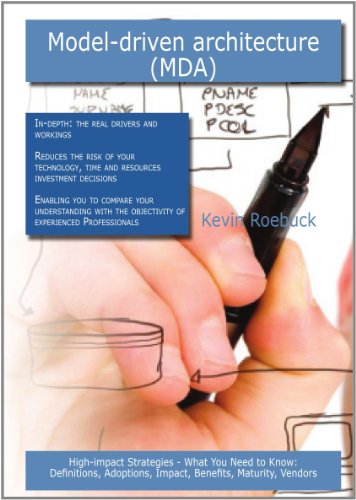Model-driven architecture (Mda): High-impact Strategies - What You Need to Know: Definitions, Adoptions, Impact, Benefits, Maturity, Vendors (Paperback)
暫譯: 模型驅動架構 (MDA):高影響力策略 - 您需要知道的事項:定義、採用、影響、好處、成熟度、供應商 (平裝本)
Kevin Roebuck
- 出版商: Tebbo
- 出版日期: 2011-05-31
- 售價: $2,165
- 貴賓價: 9.5 折 $2,057
- 語言: 英文
- 頁數: 548
- 裝訂: Paperback
- ISBN: 1743044739
- ISBN-13: 9781743044735
無法訂購
買這商品的人也買了...
-
 Scikit-learn 詳解與企業應用:機器學習最佳入門與實戰
Scikit-learn 詳解與企業應用:機器學習最佳入門與實戰$880$695 -
 Excel × ChatGPT × Power Automate 自動化處理.效率提昇便利技
Excel × ChatGPT × Power Automate 自動化處理.效率提昇便利技$499$394 -
 $2,660Generative Deep Learning: Teaching Machines to Paint, Write, Compose, and Play, 2/e (Paperback)
$2,660Generative Deep Learning: Teaching Machines to Paint, Write, Compose, and Play, 2/e (Paperback) -
 Staff 工程師之路|獻給個人貢獻者成長與改變的導航指南 (The Staff Engineer's Path)
Staff 工程師之路|獻給個人貢獻者成長與改變的導航指南 (The Staff Engineer's Path)$580$458 -
 LLM 大型語言模型的絕世祕笈:27路獨步劍法,帶你闖蕩生成式 AI 的五湖四海 (iThome鐵人賽系列書)
LLM 大型語言模型的絕世祕笈:27路獨步劍法,帶你闖蕩生成式 AI 的五湖四海 (iThome鐵人賽系列書)$650$507 -
 AI 繪圖邁向視覺設計
AI 繪圖邁向視覺設計$720$569 -
 SRE 工作現場直擊!:維運起點 x 實戰經驗 x 職涯規劃面面觀(iThome鐵人賽系列書)
SRE 工作現場直擊!:維運起點 x 實戰經驗 x 職涯規劃面面觀(iThome鐵人賽系列書)$600$396
相關主題
商品描述
This book is your ultimate resource for Model-driven architecture (MDA). Here you will find the most up-to-date information, analysis, background and everything you need to know.
In easy to read chapters, with extensive references and links to get you to know all there is to know about Model-driven architecture (MDA) right away, covering: Model-driven architecture, List of types of systems engineering, Systems engineering, APSYS, ATLAS Transformation Language, Axiomatic design, Axiomatic product development lifecycle, Bayesian experimental design, Behavior Trees, Biological systems engineering, Artifact-centric business process model, Business process modeling, Capability (systems engineering), Change management (engineering), Change request, Control engineering, Control system, Control System Integrators Association, Critical to quality, CTQ tree, Design of experiments, Design review (US Government), Design structure matrix, Dialog system, Domain engineering, Dual Vee Model, Dualistic Petri nets, Dynamic programming, Earth systems engineering and management, Electrical system design, Engineering design process, Enterprise modelling, Enterprise systems engineering, Event tree, Executable Architecture, Factorial experiment, Failure mode, effects, and criticality analysis, Failure Reporting, Analysis and Corrective Action Systems, Fault detection and isolation, Fault tree analysis, Fault-tolerant system, Feature-oriented domain analysis, Fit/Gap Analysis, Fractional factorial design, Function model, Functional specification, Human factors integration, Hybricon Corporation, IDEF, IDEF0, IDEF4, IDEF6, IEC 62264, IEC 62379, Information flow diagram, Information Systems Security Engineering, Innovations in Systems and Software Engineering, Instrument mechanic, Integrated Enterprise Modeling, Integrated logistics support, Integration Competency Center, Interface Control Document, International Council on Systems Engineering, ISMART, ISO 15288, Journal of Environmental Engineering, Journal of Systems and Software, Lean Integration, Leonardi Framework, Life-critical system, Linear stage, List of systems engineers, Meta-process modeling, Middleware, Minimum viable product, MIT Engineering Systems Division, Model transformation, Model transformation language, Model-driven engineering, Model-driven integration, Modeling perspective, Modular design, Modular Function Deployment, MOF Model to Text Transformation Language, Motion system, New product development, Non-functional requirements framework, Operational View, Optimal design, Planning, Platform-independent model, Platform-specific model, Point of Delivery, Predispositioning Theory, PREview, Problem domain, Problem Frames Approach, Process architecture, Process modeling, Process-data diagram, Procurement, Program Evaluation and Review Technique, Project Anatomy, Ptolemy Project (computing), Purchasing, QVT, Reference model, Reliability engineering, Reliability, Availability and Serviceability, Requirements analysis, Requirements management, Response surface methodology, Sampled data systems, Scenario planning, Seven Management and Planning Tools, Single point of failure, Smart System, Software system, Spacecraft design, Spare part, Starmad, Statement of work...and much more.
This book explains in-depth the real drivers and workings of Model-driven architecture (MDA). It reduces the risk of your technology, time and resources investment decisions by enabling you to compare your understanding of Model-driven architecture (MDA) with the objectivity of experienced professionals.
商品描述(中文翻譯)
模型驅動架構(Model-driven architecture, MDA)是一種用於軟體系統開發的軟體設計方法。它提供了一套指導方針,用於結構化規範,這些規範以模型的形式表達。模型驅動架構是一種領域工程,並支持軟體系統的模型驅動工程。該方法由物件管理集團(Object Management Group, OMG)於2001年推出。
本書是您了解模型驅動架構(MDA)的終極資源。在這裡,您將找到最新的信息、分析、背景以及您需要了解的一切。
在易於閱讀的章節中,提供了廣泛的參考資料和鏈接,讓您立即了解有關模型驅動架構(MDA)的所有知識,涵蓋以下主題:模型驅動架構、系統工程類型列表、系統工程、APSYS、ATLAS轉換語言、公理設計、公理產品開發生命周期、貝葉斯實驗設計、行為樹、生物系統工程、以工件為中心的業務流程模型、業務流程建模、能力(系統工程)、變更管理(工程)、變更請求、控制工程、控制系統、控制系統整合協會、關鍵品質(Critical to quality, CTQ)、CTQ樹、實驗設計、美國政府設計審查、設計結構矩陣、對話系統、領域工程、雙V模型、雙重彼得里網、動態規劃、地球系統工程與管理、電氣系統設計、工程設計過程、企業建模、企業系統工程、事件樹、可執行架構、因子實驗、故障模式、效應與關鍵性分析、故障報告、分析與糾正行動系統、故障檢測與隔離、故障樹分析、容錯系統、特徵導向領域分析、適合/差距分析、分數因子設計、功能模型、功能規範、人因整合、Hybricon Corporation、IDEF、IDEF0、IDEF4、IDEF6、IEC 62264、IEC 62379、信息流圖、信息系統安全工程、系統與軟體工程的創新、儀器機械、綜合企業建模、綜合後勤支持、整合能力中心、介面控制文件、國際系統工程委員會、ISMART、ISO 15288、環境工程期刊、系統與軟體期刊、精益整合、Leonardi框架、生命關鍵系統、線性階段、系統工程師列表、元過程建模、中介軟體、最小可行產品、麻省理工學院工程系統部、模型轉換、模型轉換語言、模型驅動工程、模型驅動整合、建模視角、模組化設計、模組化功能部署、MOF模型到文本轉換語言、運動系統、新產品開發、非功能性需求框架、操作視圖、最佳設計、規劃、平台獨立模型、平台特定模型、交付點、預置理論、PREview、問題領域、問題框架方法、過程架構、過程建模、過程數據圖、採購、計劃評估與審查技術、項目解剖、托勒密計畫(計算)、採購、QVT、參考模型、可靠性工程、可靠性、可用性與可維護性、需求分析、需求管理、響應面方法、取樣數據系統、情境規劃、七大管理與規劃工具、單點故障、智慧系統、軟體系統、航天器設計、備件、Starmad、工作聲明……以及更多內容。
本書深入解釋了模型驅動架構(MDA)的真正驅動因素和運作方式。它通過使您能夠將對模型驅動架構(MDA)的理解與經驗豐富的專業人士的客觀性進行比較,降低了您在技術、時間和資源投資決策中的風險。











